ABS Citroen JUMPY MULTISPACE 2010 2.G Owner's Manual
[x] Cancel search | Manufacturer: CITROEN, Model Year: 2010, Model line: JUMPY MULTISPACE, Model: Citroen JUMPY MULTISPACE 2010 2.GPages: 235, PDF Size: 11.2 MB
Page 28 of 235
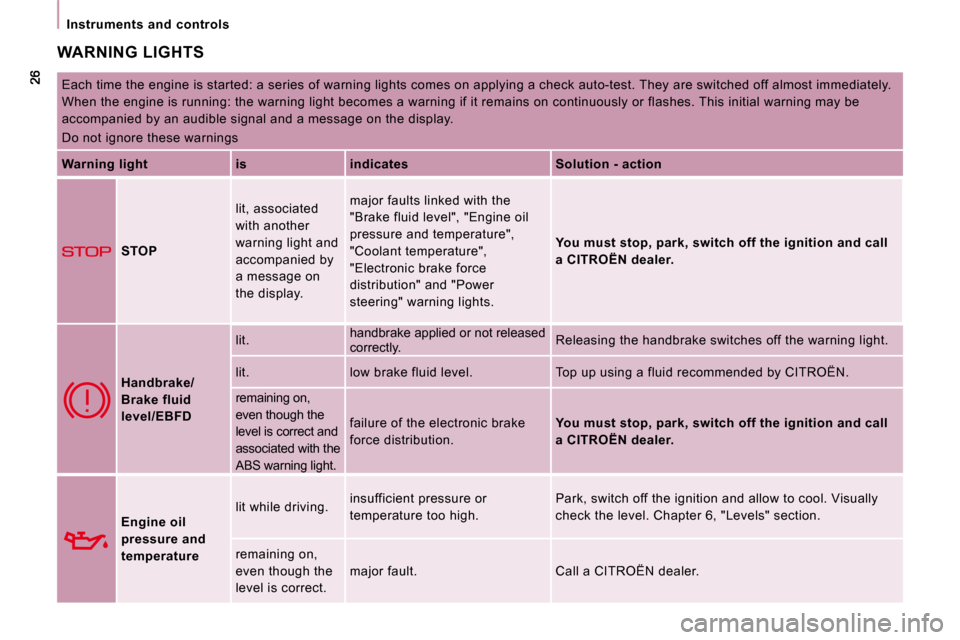
Instruments and controls
WARNING LIGHTS
Each time the engine is started: a series of warning lights comes on applying a check auto-test. They are switched off almost immediately.
When the engine is running: the warning light becom es a warning if it remains on continuously or flashes. This initial warning may be
accompanied by an audible signal and a message on t he display.
Do not ignore these warnings
Warning light is indicates Solution - action
STOP lit, associated
with another
warning light and
accompanied by
a message on
the display. major faults linked with the
"Brake fluid level", "Engine oil
pressure and temperature",
"Coolant temperature",
"Electronic brake force
distribution" and "Power
steering" warning lights.
You must stop, park, switch off the ignition and ca ll
a
CITROËN dealer.
Handbrake/
Brake fluid
level/EBFD lit.
handbrake applied or not released
correctly. Releasing the handbrake switches off the warning l
ight.
lit. low brake fluid level. Top up using a fluid recommended by CITROËN.
remaining on,
even though the
level is correct and
associated with the
ABS warning light. failure of the electronic brake
force distribution.
You must stop, park, switch off the ignition and ca ll
a CITROËN dealer.
Engine oil
pressure and
temperature lit while driving.
insufficient pressure or
temperature too high. Park, switch off the ignition and allow to cool. V
isually
check the level. Chapter 6, "Levels" section.
remaining on,
even though the
level is correct. major fault. Call a CITROËN dealer.
Page 31 of 235
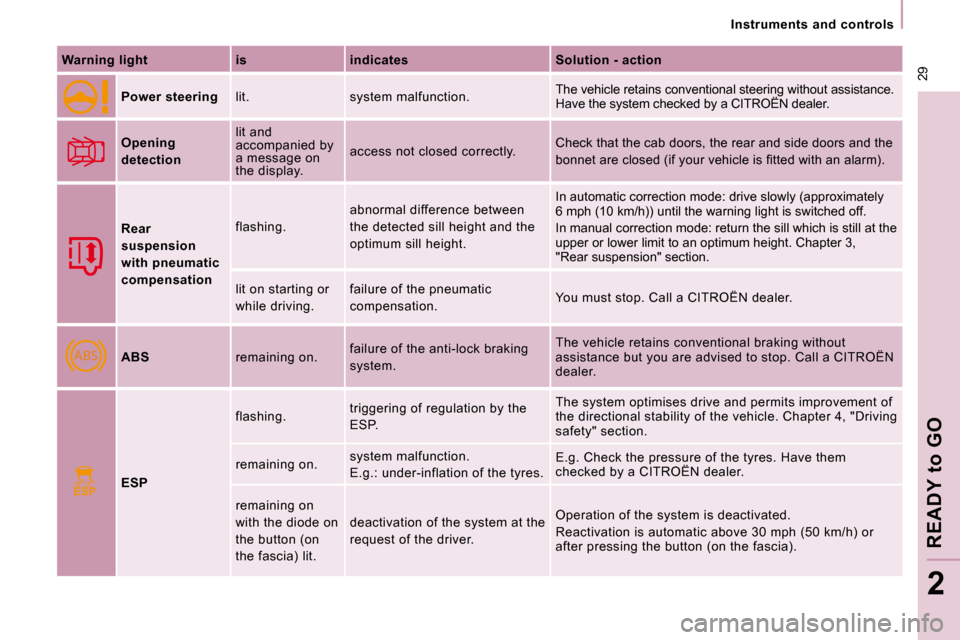
ABS
ESP
29
Instruments and controls
READY
to
GO
2
Warning light is indicates Solution - action
Power steering lit. system malfunction. The vehicle retains conventional steering without
assistance.
Have the system checked by a CITROËN dealer.
Opening
detection lit and
accompanied by
a message on
the display.
access not closed correctly.
Check that the cab doors, the rear and side doors
and the
�b�o�n�n�e�t� �a�r�e� �c�l�o�s�e�d� �(�i�f� �y�o�u�r� �v�e�h�i�c�l�e� �i�s� �fi� �t�t�e�d� �w�i�t�h� �a �n� �a�l�a�r�m�)�.
Rear
suspension
with pneumatic
compensation flashing.
abnormal difference between
the detected sill height and the
optimum sill height. In automatic correction mode: drive slowly (approximately
6 mph (10 km/h)) until the warning light is switched off.
In manual correction mode: return the sill which is still at th
e
upper or lower limit to an optimum height. Chapter 3,
"Rear suspension" section.
lit on starting or
while driving. failure of the pneumatic
compensation.
You must stop. Call a CITROËN dealer.
ABS remaining on. failure of the anti-lock braking
system. The vehicle retains conventional braking without
assistance but you are advised to stop. Call a CITR
OËN
dealer.
ESP flashing.
triggering of regulation by the
ESP. The system optimises drive and permits improvement
of
the directional stability of the vehicle. Chapter 4 , "Driving
safety" section.
remaining on. system malfunction.
E.g.: under-inflation of the tyres. E.g. Check the pressure of the tyres. Have them
checked by a CITROËN dealer.
remaining on
with the diode on
the button (on
the fascia) lit. deactivation of the system at the
request of the driver.
Operation of the system is deactivated.
Reactivation is automatic above 30 mph (50 km/h) o
r
after pressing the button (on the fascia).
Page 65 of 235
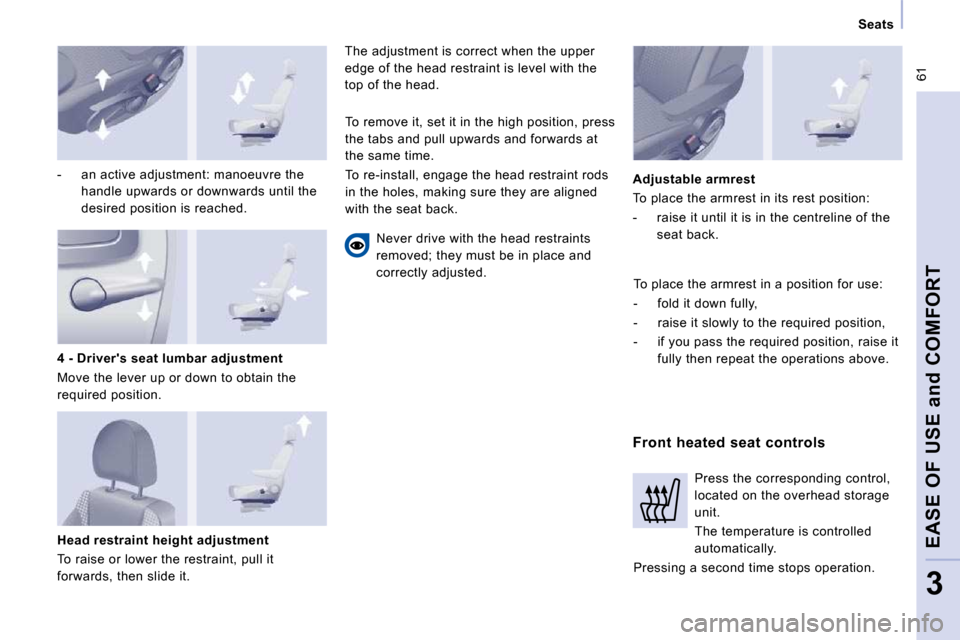
61
Seats
EASE OF USE and COMFORT
3
- an active adjustment: manoeuvre the handle upwards or downwards until the
desired position is reached.
Head restraint height adjustment
To raise or lower the restraint, pull it
forwards, then slide it. The adjustment is correct when the upper
edge of the head restraint is level with the
top of the head.
Never drive with the head restraints
removed; they must be in place and
correctly adjusted.
Front heated seat controls
Adjustable armrest
To place the armrest in its rest position:
- raise it until it is in the centreline of the
seat back.
4 - Driver's seat lumbar adjustment
Move the lever up or down to obtain the
required position. To remove it, set it in the high position, press
the tabs and pull upwards and forwards at
the same time.
To re-install, engage the head restraint rods
in the holes, making sure they are aligned
with the seat back.
To place the armrest in a position for use:
- fold it down fully,
- raise it slowly to the required position,
- if you pass the required position, raise it fully then repeat the operations above.
Press the corresponding control,
located on the overhead storage
unit.
The temperature is controlled
automatically.
Pressing a second time stops operation.
Page 66 of 235

2-SEAT FRONT BENCH
If your vehicle is fitted with this bench seat,
it is fixed and has a 3rd seat belt.
Head restraint
Press the tab to adjust the height of the
head restraint.
To remove the head restraint, press the tabs
and raise the head restraint.
The adjustment is correct when the upper
edge of the head restraint is level with the
top of the head.
Never drive with the head restraints
removed; they must be in place and
adjusted correctly.
Seat back pockets
If your vehicle is fitted with these, they are
located on the backs of the front seats.
62
Seats
Page 92 of 235

ABS
ABS
Driving safely
SAFETY
4
HORN
Press the centre of the steering wheel.
ANTI-LOCK BRAKING SYSTEM (ABS - EBFD)
The ABS and EBFD (electronic brake force
distribution) systems improve the stability
and manoeuvrability of your vehicle on
braking, in particular on poor or slippery
surfaces.
The ABS prevents locking of the wheels,
the EBFD provides control of the braking
pressure wheel by wheel.
Good practice
The anti-lock braking system comes into
operation automatically when there is a risk
of wheel lock. It does not reduce the braking
distance.
On very slippery surfaces (ice, oil, etc...)
the ABS may increase the braking distance.
When braking in an emergency, do not
hesitate to press the brake pedal firmly,
without releasing the pressure, even on a
slippery surface, you will then be able to
continue to manoeuvre the vehicle to avoid
an obstacle.
Normal operation of the ABS may be felt by
slight vibration of the brake pedal.
When changing wheels (tyres and rims),
ensure that these are recommended by
CITROËN. If this warning light comes on,
together with the brake and STOP
warning lights, accompanied by
an audible signal and a message
on the display, it indicates a malfunction of
the electronic brake force distribution which
could result in a loss of control of the vehicle
on braking.
Stop immediately.
EMERGENCY BRAKING ASSISTANCE SYSTEM (EBA)
In an emergency, this system enables the
optimum braking pressure to be reached
more quickly, press the pedal firmly without
releasing it.
It is triggered by the speed at which the
brake pedal is activated.
This alters the resistance of the brake pedal
under your foot.
If this warning light comes on,
accompanied by an audible signal
and a message on the display, it
indicates a malfunction of the ABS
which could result in a loss of control of the
vehicle on braking. In both cases, contact a CITROËN dealer.
To prolong the operation of the emergency
braking assistance system: keep your foot
on the brake pedal.
Page 93 of 235
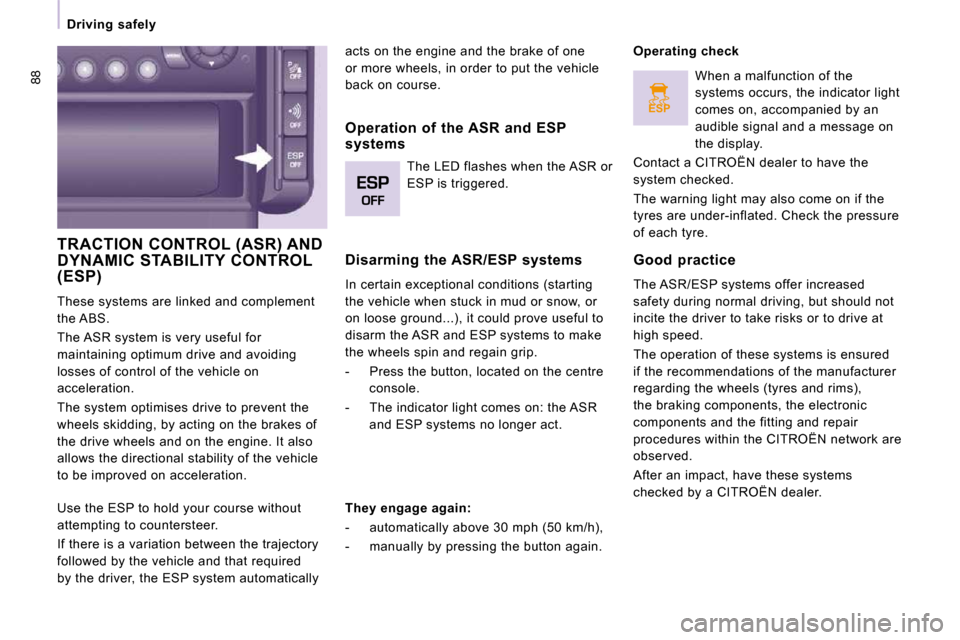
ESP
88
Driving safely
TRACTION CONTROL (ASR) AND DYNAMIC STABILITY CONTROL (ESP)
These systems are linked and complement
the ABS.
The ASR system is very useful for
maintaining optimum drive and avoiding
losses of control of the vehicle on
acceleration.
The system optimises drive to prevent the
wheels skidding, by acting on the brakes of
the drive wheels and on the engine. It also
allows the directional stability of the vehicle
to be improved on acceleration. acts on the engine and the brake of one
or more wheels, in order to put the vehicle
back on course.
Disarming the ASR/ESP systems
In certain exceptional conditions (starting
the vehicle when stuck in mud or snow, or
on loose ground...), it could prove useful to
disarm the ASR and ESP systems to make
the wheels spin and regain grip.
- Press the button, located on the centre
console.
- The indicator light comes on: the ASR and ESP systems no longer act. Operating check
Good practice
The ASR/ESP systems offer increased
safety during normal driving, but should not
incite the driver to take risks or to drive at
high speed.
The operation of these systems is ensured
if the recommendations of the manufacturer
regarding the wheels (tyres and rims),
the braking components, the electronic
components and the fitting and repair
procedures within the CITROËN network are
observed.
After an impact, have these systems
checked by a CITROËN dealer.
Operation of the ASR and ESP systems
The LED flashes when the ASR or
ESP is triggered.
They engage again:
- automatically above 30 mph (50 km/h),
- manually by pressing the button again. When a malfunction of the
systems occurs, the indicator light
comes on, accompanied by an
audible signal and a message on
the display.
Contact a CITROËN dealer to have the
system checked.
The warning light may also come on if the
tyres are under-inflated. Check the pressure
of each tyre.
Use the ESP to hold your course without
attempting to countersteer.
If there is a variation between the trajectory
followed by the vehicle and that required
by the driver, the ESP system automatically
Page 109 of 235

102
Child safety
Deactivate the passenger airbag when a
"rear facing" child seat is installed on the
front seat.
Otherwise, the child would risk being
seriously injured or killed if the airbag were
to inflate. Installing a booster seat
The chest part of the seat belt must be
positioned on the child's shoulder without
touching the neck.
Ensure that the lap part of the seat belt
passes correctly over the child's thighs.
CITROËN recommends the use of a booster
seat which has a back, fitted with a seat belt
guide at shoulder level.
ADVICE ON CHILD SEATS
The incorrect installation of a child seat in a
vehicle compromises the child's protection in
the event of an accident.
Remember to fasten the seat belts or the
child seat harnesses keeping the slack in
relation to the child's body to a minimum ,
even for short journeys.
For optimum installation of the "forward
facing" child seat, ensure that the back of
the child seat is in contact with the back of
the vehicle's seat and that the head restraint
does not cause any discomfort.
If the head restraint has to be removed,
ensure that it is stored or attached securely
to prevent it from being thrown around the
vehicle in the event of sharp braking.
Children under the age of 10 must not travel
in the "forward facing" position on the front
passenger seat, unless the rear seats are
already occupied by other children, cannot
be used or are absent. As a safety precaution, do not leave:
- one or more children alone and
unsupervised in a vehicle,
- a child or an animal in a vehicle which is exposed to the sun, with the windows
closed,
- the keys within reach of children inside the vehicle.
To prevent accidental opening of the doors,
use the "Child Lock".
Take care not to open the rear windows by
more than one third.
To protect young children from the rays of
the sun, fit side blinds to the rear windows.
Page 111 of 235
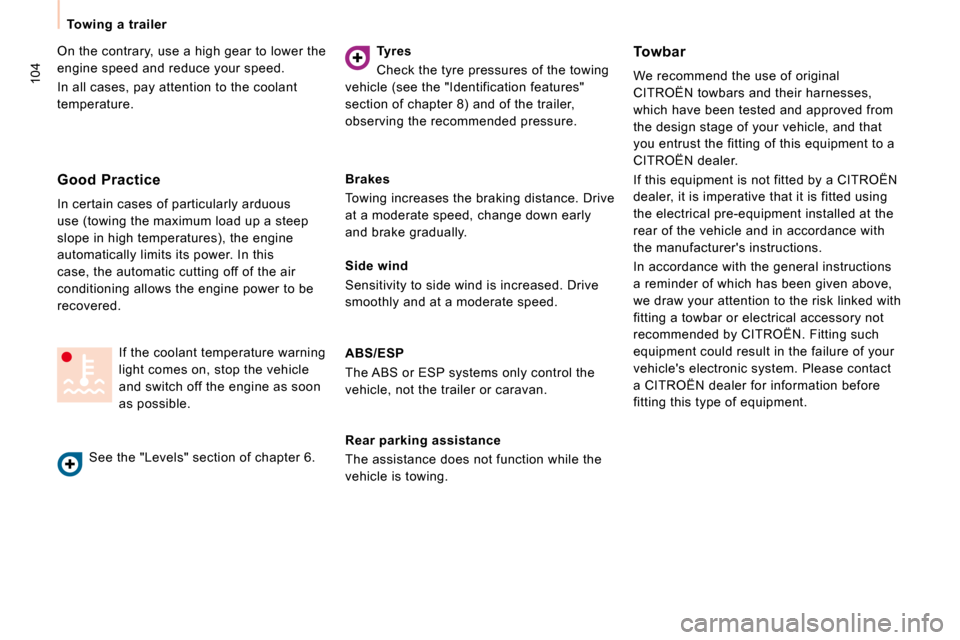
104
Towing a trailer
On the contrary, use a high gear to lower the
engine speed and reduce your speed.
In all cases, pay attention to the coolant
temperature.
Tyres
Check the tyre pressures of the towing
vehicle (see the "Identification features"
section of chapter 8) and of the trailer,
observing the recommended pressure. Towbar
We recommend the use of original
CITROËN towbars and their harnesses,
which have been tested and approved from
the design stage of your vehicle, and that
you entrust the fitting of this equipment to a
CITROËN dealer.
If this equipment is not fitted by a CITROËN
dealer, it is imperative that it is fitted using
the electrical pre-equipment installed at the
rear of the vehicle and in accordance with
the manufacturer's instructions.
In accordance with the general instructions
a reminder of which has been given above,
we draw your attention to the risk linked with
fitting a towbar or electrical accessory not
recommended by CITROËN. Fitting such
equipment could result in the failure of your
vehicle's electronic system. Please contact
a CITROËN dealer for information before
fitting this type of equipment.
If the coolant temperature warning
light comes on, stop the vehicle
and switch off the engine as soon
as possible.
Good Practice
In certain cases of particularly arduous
use (towing the maximum load up a steep
slope in high temperatures), the engine
automatically limits its power. In this
case, the automatic cutting off of the air
conditioning allows the engine power to be
recovered.
See the "Levels" section of chapter 6.
Brakes
Towing increases the braking distance. Drive
at a moderate speed, change down early
and brake gradually.
Side wind
Sensitivity to side wind is increased. Drive
smoothly and at a moderate speed.
ABS/ESP
The ABS or ESP systems only control the
vehicle, not the trailer or caravan.
Rear parking assistance
The assistance does not function while the
vehicle is towing.
Page 135 of 235

Changing a bulb
QUICK HELP
7
REAR LIGHTS
For further information concerning the bulbs,
refer to the "Types of bulb". - Identify the faulty bulb then open
the rear doors to 180°. Refer to the
"Accesses" section of chapter 2.
- Remove the two fixing nuts.
Pull the lens block from the outside.
- Holding the light, disconnect the electrical connector. - Move aside the 8 tabs then extract the
bulb holder.
- Remove the faulty bulb by pressing it lightly while turning it anticlockwise.
- Change the bulb.
1. Brake lights/side lights
Type B , P21/5W - 21/5W
2. Direction indicators
Type B , PY21W - 21W (amber)
3. Reversing lights
Type B , P21W - 21W
4. Fog lamps
Type B , P21W - 21W When refitting, take care to correctly
reposition:
- the 8 tabs,
- the two white lugs in the two rubber
holes to maintain the sealing of the light,
- the supply wire to avoid trapping it.
Page 136 of 235

128
Changing a bulb
THIRD BRAKE LIGHT
Type A , W5W - 5W
Type B , P21W - 21W
NUMBER PLATE LIGHTS
Type A , W5W - 5W
With tailgate
- Move aside the plastic lens using a screwdriver, on the point indicated by
the arrow.
- Change the bulb.
- Replace the plastic lens and press on it.
With hinged doors
- Unclip the interior trim.
- Disconnect the connector by moving aside its tab.
- Remove the plastic cover.
- Turn the bulb holder a quarter turn anticlockwise.
- Change the bulb. Light located on the outside
(hinged doors)
- Unscrew the two screws using a Torx
TM
screwdriver with 20 socket.
- Remove the light.
- Change the bulb. Light located on the inside (tailgate)
- Unscrew the two screws using a Torx
TM
screwdriver with 20 socket.
- Remove the plastic cover.
- Remove the bulb holder moving aside the two tabs.
- Remove the faulty bulb by pressing it lightly while turning it anticlockwise.
- Change the bulb.